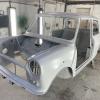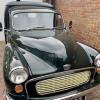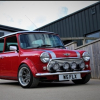
Engine Break In Oil And Procedure Advice
#16

Posted 02 December 2023 - 10:17 AM
Remove the spark plugs, turn the engine over on the starter motor until the oil light goes out/or the oil pressure registers pressure. Replace spark plugs.
Start the engine as you would in normal use. There is no need to run the engine at 3000 RPM for 20 minutes. Just treat the engine as if it was new for the 100 miles then off you go.
To obtain maximum performance on PH3/4/5 cams a visit down to the rolling road is advisable.
Just to throw a spanner in the works, the above is straight off of a well known camshaft manufacturer's website, enjoy.
Shooter
#17

Posted 02 December 2023 - 11:56 AM
Starting the Engine:-
Remove the spark plugs, turn the engine over on the starter motor until the oil light goes out/or the oil pressure registers pressure. Replace spark plugs.
Start the engine as you would in normal use. There is no need to run the engine at 3000 RPM for 20 minutes. Just treat the engine as if it was new for the 100 miles then off you go.
To obtain maximum performance on PH3/4/5 cams a visit down to the rolling road is advisable.
Just to throw a spanner in the works, the above is straight off of a well known camshaft manufacturer's website, enjoy.
Shooter
Interesting.
Which Cam manufacturer is that from ?
#18

Posted 02 December 2023 - 12:27 PM
Starting the Engine:-
Remove the spark plugs, turn the engine over on the starter motor until the oil light goes out/or the oil pressure registers pressure. Replace spark plugs.
Start the engine as you would in normal use. There is no need to run the engine at 3000 RPM for 20 minutes. Just treat the engine as if it was new for the 100 miles then off you go.
To obtain maximum performance on PH3/4/5 cams a visit down to the rolling road is advisable.
Just to throw a spanner in the works, the above is straight off of a well known camshaft manufacturer's website, enjoy.
Shooter
Interesting.
Which Cam manufacturer is that from ?
Newman Cams, in Orpington, as used by A C Dodd amongst others, one of the few companies in this country which will do short run/bespoke cams and I always think a tad under used by the mini community.
Shooter
#19

Posted 02 December 2023 - 02:13 PM
#20

Posted 02 December 2023 - 02:20 PM
Just treat the engine as if it was new for the 100 miles then off you go.
No room for confusion there then.
#21

Posted 02 December 2023 - 11:17 PM
Newman Cams, in Orpington, as used by A C Dodd amongst others, one of the few companies in this country which will do short run/bespoke cams and I always think a tad under used by the mini community.
Shooter
OK, many thanks for that.
I did find that info in a download from their website. I also noted that - if I read that right - they Nitride their Cams and so these may no need the usual break in process, however, read on, what APT, a leading US Cam Manufacturer suggests.
This is advicies (is that a word ?) from a few other Cam manufacturers;-
Crane Cams;-

Piper Cams;-

And APT who also Nitride their Cams;-

All other Cam Grinders and Manufacturer's advice that I have came across over the years all suggest pretty much the same thing.
There does seem to be a common theme between them all. I'd suggest if in doubt or unless the Cam Grinder / Manufacturer suggests otherwise, follow the procedures here, it can't hurt anything, even in light of what Newman suggest.
#22

Posted 03 December 2023 - 10:30 AM
Newman Cams, in Orpington, as used by A C Dodd amongst others, one of the few companies in this country which will do short run/bespoke cams and I always think a tad under used by the mini community.
Shooter
OK, many thanks for that.
I did find that info in a download from their website. I also noted that - if I read that right - they Nitride their Cams and so these may no need the usual break in process, however, read on, what APT, a leading US Cam Manufacturer suggests.
This is advicies (is that a word ?) from a few other Cam manufacturers;-
Crane Cams;-
Piper Cams;-
And APT who also Nitride their Cams;-
All other Cam Grinders and Manufacturer's advice that I have came across over the years all suggest pretty much the same thing.
There does seem to be a common theme between them all. I'd suggest if in doubt or unless the Cam Grinder / Manufacturer suggests otherwise, follow the procedures here, it can't hurt anything, even in light of what Newman suggest.
I just thought I'd throw it out there, recently I spent a very unhappy couple of hours machining the lobes off a O/E camshaft to use as a jackshaft for a 16v build I'm doing, I ground the lobes to a rough round before setting it up in the lathe, you can tell by the colour of the sparks coming off when grinding that the metal was bloody hard, I think I went through 2-3 tips to do all 8 lobes, I ended up with a slow speed and feed and very light cuts. Personally I'm a 20 minute guy to do what I call " take the heat out of the engine" then drive it normally, is it right, I don't know, but I've never had one glaze up yet. My latest engine that I'm building ( project biggy smalls ) will get the same, fill the engine with break in oil for a 100 miles, change over to the normal stuff and let the fun begin.
Shooter
#23

Posted 03 December 2023 - 05:30 PM
Just to thank you all for contributions. Spider, very insightful stuff, thank you - appreciate the details very much, specially regarding cleaning the cylinders after boring - think I'm good there ![]()
I will go with the Penrite break in oil as price is not too bad and switch to their classic mini oil after. Spider, I note in your instructions that engine oil change should be done after run in period, about 500km. Also, curious as to why you recommend water rather than coolant for the break in period?
Regarding cam, I got a new one supplied by the same machine shop - will ask for some details. The profile is a Kent Cams 266 profile. Also using new followers:
https://www.minispar...fts/AEG584.aspx
So I guess I'll have to drive it to apply load to break in the cylinder/piston ring.
Best,
MMP
#24

Posted 03 December 2023 - 09:01 PM
Just to thank you all for contributions. Spider, very insightful stuff, thank you - appreciate the details very much, specially regarding cleaning the cylinders after boring - think I'm good there
I will go with the Penrite break in oil as price is not too bad and switch to their classic mini oil after. Spider, I note in your instructions that engine oil change should be done after run in period, about 500km. Also, curious as to why you recommend water rather than coolant for the break in period?
Regarding cam, I got a new one supplied by the same machine shop - will ask for some details. The profile is a Kent Cams 266 profile. Also using new followers:
https://www.minispar...fts/AEG584.aspx
So I guess I'll have to drive it to apply load to break in the cylinder/piston ring.
Best,
MMP
Phew ! I'm glad I didn't waffle on too much there and loose you !
Much of the initial engine break in is done in the first roughly 100 km, however it won't get a full seal on the rings until you clock up around 3000 - 5000 km ![]()
The main reason to keep the engine speeds and load low early on is to prevent the high (and thin in section) peaks of the honing from getting too hot as they can locally harden and end up being razors on the rings (fast run in = fast run out) . Some engine shops will Plateau Hone for a finish to reduce this risk.
You could do an Oil change sooner then the 500 km suggested, but that additional time is to be sure that the initial bedding in process has gone far enough. If the Oil is too 'slippery' too soon, there's that risk of glazing that we want to avoid. It's not likely to occur after about 100 km, but that's not guaranteed at that time.
The reason for suggesting water during the break in period is firstly, most head gaskets have a heat activated sealant on them, which will activate in the first heat cycle. Coolant has little or no surface tension, so any small passage that the sealant would take up will likely leak coolant. Water has a surface tension and so is much less likely to leak in this way. After that first heat cycle, you can go to a coolant but I didn't recommend it in case there was a leak somewhere or other rectification work that might be needed that might involve draining of the coolant.
Kent Cams (last time I looked) also recommend a similar break in procedure for their cams.
#25

Posted 04 December 2023 - 11:49 AM
The reason for suggesting water during the break in period is firstly, most head gaskets have a heat activated sealant on them, which will activate in the first heat cycle. Coolant has little or no surface tension, so any small passage that the sealant would take up will likely leak coolant. Water has a surface tension and so is much less likely to leak in this way. After that first heat cycle, you can go to a coolant but I didn't recommend it in case there was a leak somewhere or other rectification work that might be needed that might involve draining of the coolant.
Good to know re coolant and head gasket! Which coolant do you recommend Spider / anyone? (My first mini!)
Machine shop says they did a "proper" plateau hone and should be compatible with the rings. They have suggested cleaning cylinders with soapy water before rebuild. Their recommendation was just to put breaking in oil in and drive it, not let it idle, keeping the revs up to get oil splashing on cams.
Thank you.
MMP
#26

Posted 04 December 2023 - 08:08 PM
Starting the Engine:-
Remove the spark plugs, turn the engine over on the starter motor until the oil light goes out/or the oil pressure registers pressure. Replace spark plugs.
Start the engine as you would in normal use. There is no need to run the engine at 3000 RPM for 20 minutes. Just treat the engine as if it was new for the 100 miles then off you go.
To obtain maximum performance on PH3/4/5 cams a visit down to the rolling road is advisable.
Just to throw a spanner in the works, the above is straight off of a well known camshaft manufacturer's website, enjoy.
Shooter
Is that for flat tappet knock in? Everything I've read from large brands, including most state side for v8s, all mention correctly knocking the cam in to allow micro profiling of the lobe vs follower surface.
#27

Posted 04 December 2023 - 10:19 PM
Lovely SpiderThere can be a few variables in just what procedure(s) should be followed, but even before you get to this point, you need to be sure that the hone finish on the bores suits the ring and oil control ring pack. The machine shop should know, as long as they know what rings you are running.
When I had my shop, this was the contents of the sheet I'd give to customers, but bear in mind, this is based on the components I was using;-
Engine Initial Start & Running In
Oil for Running In Period
Use Penrite Running In Oil. Do not subsitute.
Initial Engine Start
1) Be sure you have a GOOD Battery
2) Test the Oil Switch on the engine. Disconnect the Black Wire between the distributor and Coil. Turn the key to RUN, the Oil Light should come ON. Disconnect the wire from the Oil Switch, it should go OFF.
DO NOT PROCEED UNTIL THIS WORKS 100% RELIABLY
3) Fill with Fuel, Water and Oil etc. Do NOT fill with Coolant at this time, only clean tap water.
4) Ensure Brakes etc are working
5) Ensure the engine is dust free. Remove the spark plugs
6) Crank the engine over (it will sound 'funny') until the Oil Light goes OFF. This may take anything from 30 secs to 5 minutes.
7) Leave it sit for a Minute and check that the Oil Light comes back ON. Crank over again and check the Oil Light goes OFF, should only take ~ 5 - 10 seconds.
8) Check for Oil Leaks. Resolve.
9) Fit Spark Plugs and HT Leads, re-connect the wire from the Distributor to the coil.
10) Be sure you have your Licence with you!
11) Start and Drive it. DO NOT ALLOW the engine revs to drop under 2000 RPM, not even for ‘a second’.
12) Drive with gentle acceleration until up to temperature.
for the first 20 minutes, keep the RPMs above 2000 RPM, then set it to 1100 RPM (run in period for Cam and / or followers).
DO NOT EXCEED THE FOLLOWING SPEEDS;-
1ST 20 KPH
2ND 40 KPH
3RD 60 KPH
4TH 80 KPH
(Basically limiting to 3000 RPM Max)
Initial Bedding in;-
13) When up to temp (about 1 - 2 minutes), on a quiet road, drive up to 50 KPH, Then in 4th Gear, accelerate HARD from 50 KPH to 80 KPH.
Do this 3 times NO MORE. Don't let the engine 'Ping'.
14) Return to Base and check over. Resolve any issues and Leave overnight.
15) Re-tension the Cylinder Head (50 ft/lbs or as recommended by the stud supplier) and Re-set the Tappets (0.012")
16) Drive around locally, observing your limited speeds, for around 200 km.
17) If all is OK, continue driving for 500 or 1000 km in total. (500 km for Iron Rings, 1000 for Chrome Rings)
18) Change Oil and Filter. Re-tension Cylinder Head and Re-set Tappets.
19) It's now run in.
20) Set idle to 650 RPM, check Ignition Timing and Carb Mixture.
21) Check for leaks, noises etc.
GOLDEN RULES while running in;-
DO NOT accelerate hard - ever
DO NOT Over-rev it (observe above limited speeds) - ever
Don't let it over-heat
Avoid Idling, up to 30 seconds is OK, but don't let it go on any longer. After you've done about 600 km, it will be OK to idle for longer periods, but still try to avoid it.
Avoid sitting on the one speed. It will be OK for a minute or so, but keep the revs changing.
Drive 'normally'
Don't ever let the engine 'Ping'
After Running In Period
Re-check Cylinder Head Tension
Re-set Tappets
Change Oil and Filter. Recommended Oil Penrite HPR30.
Drain Cooling System (ensure heater is set to HOT), flush with clean water, drain and then fill with Coolant. Penrite have a good one. Do not use Tecalloy.
There are references there to certain brands of oils and coolants, which I do know are available in the UK, though you may have to search for them.
With most ring packs, it is vital that you get some load on them right away, any by that, I mean as soon as the engine fires. If you don't, there's a risk it will glaze, and it will do that right away too. Once that happens, you'll need to have the block honed again to remove the glazing and it would also be wise to fit another set of rings again. This too is why you should only ever use a lighter oil for running in.
#28

Posted 04 December 2023 - 10:21 PM
#29

Posted 04 December 2023 - 10:23 PM
Starting the Engine:-
Remove the spark plugs, turn the engine over on the starter motor until the oil light goes out/or the oil pressure registers pressure. Replace spark plugs.
Start the engine as you would in normal use. There is no need to run the engine at 3000 RPM for 20 minutes. Just treat the engine as if it was new for the 100 miles then off you go.
To obtain maximum performance on PH3/4/5 cams a visit down to the rolling road is advisable.
Just to throw a spanner in the works, the above is straight off of a well known camshaft manufacturer's website, enjoy.
Shooter
Is that for flat tappet knock in? Everything I've read from large brands, including most state side for v8s, all mention correctly knocking the cam in to allow micro profiling of the lobe vs follower surface.
Best phone Newman and ask them, I came across it while looking for a camshaft manufacturer to modify an existing set of camshafts for an on going project.
Shooter
#30

Posted 05 December 2023 - 02:38 AM
Good to know re coolant and head gasket! Which coolant do you recommend Spider / anyone? (My first mini!)
Machine shop says they did a "proper" plateau hone and should be compatible with the rings. They have suggested cleaning cylinders with soapy water before rebuild. Their recommendation was just to put breaking in oil in and drive it, not let it idle, keeping the revs up to get oil splashing on cams.
Thank you.
MMP
Years ago I was using Castrol Coolant, but that changed when BP took them over, it's not nearly the same. These days I use Penrite, but be sure what ever you do use it's compatible with all the metals in your cooling system.
Regarding the second question, read below.
I'm in a similar situation. They will soon finish rebuilding my engine, and I've a doubt about what oil to put in first. The Millers metallic can, which is a very thick oil, or the can of 20w-50 basic oil from the hypermarket.
I did neglect to say in my first post in this thread that if the machine shop has given advice / instructions (in the case of self assembly) then perhaps follow that, but I would also suggest reading up the advice from the Ring and Cam manufacturer and draw your own conclusions.
If the engine has been assembled by a shop, as it sounds in your case Pacino, then forget anything in this thread or anywhere else and seek instructions from the engine builder. It is their warranty and I'm sure if you deviated from their instructions it could well void their warranty.
1 user(s) are reading this topic
0 members, 1 guests, 0 anonymous users

















